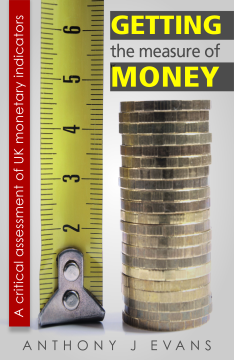
BOOK
Getting the Measure of Money: A Critical Assessment of UK Monetary Indicators
(2018)
Additional Information
Book Details
Abstract
How much money is circulating in the United Kingdom? The question sounds simple. In fact, it is notoriously difficult to answer, because what counts as money is not a straightforward matter. A variety of measures have been advanced, and they tell different stories about the changing supply of money in an economy. These differences are of more than merely academic interest, because measures of the money supply are inputs to the decisions of central banks. Wrong answers can lead to wrong actions, with potentially devastating economic effects. This book examines the measure of money and, in that light, the actions of the Bank of England in in the lead up to the 2008 financial crisis and its aftermath. It is essential reading for anyone interested in money, measures of its quantity, and the relationship between the money supply and the economic cycle.
Table of Contents
| Section Title | Page | Action | Price |
|---|---|---|---|
| Table 1\tNotes and Coin breakdown | 31 | ||
| Table 2\tMA data series and backdating methods | 44 | ||
| Table 3\tCPI vs PPI (input) | 101 | ||
| Table 4\tImpact summary | 117 | ||
| Figure 1\tM4 and M4ex, 1998–2009 (year-on-year % change) | 10 | ||
| Figure 2\tTrue Money Supply | 20 | ||
| Figure 3\tMA stock, 1990–2016 (£million) | 28 | ||
| Figure 4\tMA growth, 1991–2016 (year-on-year % change) | 29 | ||
| Figure 5\tMonetary aggregates, September 2014 (£million) | 34 | ||
| Figure 6\tMonetary aggregates, 2004–16 (£million) | 35 | ||
| Figure 7\tM3 and MA, 2004–16 (year-on-year growth rates) | 36 | ||
| Figure 8\tDivisia money, 2000–2016 (year-on-year % growth) | 40 | ||
| Figure 9\tBroad money velocity, 2007–10 (% change) | 58 | ||
| Figure 10\tPolicy uncertainty | 72 | ||
| Figure 11\tPrivate investment, 2007–16 (year-on-year % growth) | 78 | ||
| Figure 12\tInflation and price level (under inflation expectations) | 84 | ||
| Figure 13\tAugust 2006 fan chart | 92 | ||
| Figure 14\tAugust 2008 fan chart | 93 | ||
| Figure 15\tRPIX and CPI, 1997–2009 | 98 | ||
| Figure 16\tCPI and PPI, May 1997–Dec 2009 (monthly data, % change from previous year). | 100 | ||
| Figure 17\tActual and multi-factor productivity norm CPI growth, 1997–2014 (annual data, % change from previous year) | 113 | ||
| Figure 18\tActual and productivity norm CPI level, 1997–2016 (quarterly data, 1997 = 100) | 114 | ||
| Figure 19\tActual and productivity norm CPI growth, 1997–2016 (quarterly data, % change from previous year) | 115 | ||
| Figure 20\tMulti-factor productivity, 1997–2014 | 125 | ||
| Figure 21\tStructure of production | 145 | ||
| Figure 22\tStructure of production (GDP) | 146 | ||
| Figure 23\tStructure of production (GO) | 147 | ||
| Figure 24\tGO vs NGDP, 1997–2014 (£million) | 150 | ||
| Figure 25\tGO to NGDP ratio, 1997–2014 | 151 | ||
| Figure 26\tGO and NGDP growth, 1998–2014 | 152 | ||
| Figure 27\tUK payments, 1990–2013 (2006 = 100) | 154 | ||
| Figure 28\tUK payments growth (% change on previous year) | 154 | ||
| The author | ix | ||
| Preface | x | ||
| Acknowledgements | xiii | ||
| Summary | xiv | ||
| Tables and figures | xvi | ||
| 1\tIntroduction | 1 | ||
| 2\tM: The importance of alternative monetary aggregates | 8 | ||
| Summary of key points | 8 | ||
| Introduction | 9 | ||
| Can money be measured? | 13 | ||
| Austrian definitions of the money supply | 18 | ||
| The Goldilocks measure | 29 | ||
| Divisia money | 36 | ||
| Conclusion | 42 | ||
| 3\tV: Velocity shocks, regime uncertainty and the central bank | 46 | ||
| Summary of key points | 46 | ||
| The demand for money | 49 | ||
| Supplier-induced demand and central banks | 62 | ||
| Regime uncertainty and big players | 67 | ||
| Conclusion | 79 | ||
| 4\tP: The hidden inflation of the great moderation | 80 | ||
| Summary of key points | 80 | ||
| Introduction | 81 | ||
| Inflation vs price-level targets | 84 | ||
| Fan charts | 89 | ||
| Price indices | 94 | ||
| Productivity norm | 103 | ||
| Conclusion | 115 | ||
| 5\tY: GDP, GO and the structure of production | 119 | ||
| Summary of key points | 119 | ||
| Introduction | 119 | ||
| National income accounting | 123 | ||
| Beyond GDP | 130 | ||
| Gross production and capital consumption | 135 | ||
| Evidence for the UK economy | 148 | ||
| Conclusion | 155 | ||
| 6\tConclusion | 157 | ||
| The dynamic process of economic crises | 158 | ||
| Policy conclusions | 162 | ||
| References | 167 | ||
| About the IEA | 186 | ||
| Blank Page | ii |
